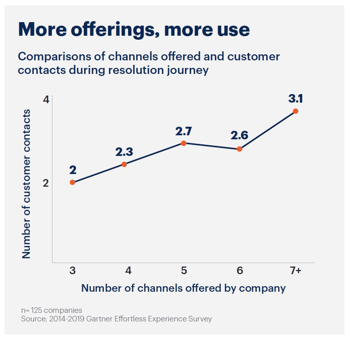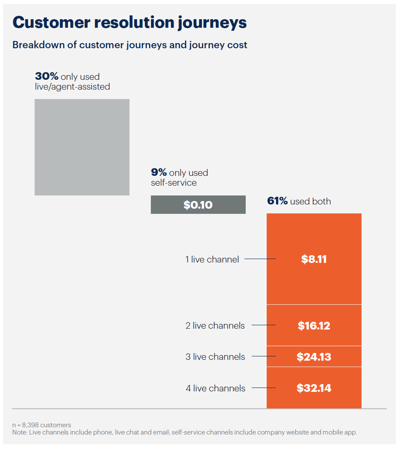
On JULY 13, 2021
The Secret to Delivering an Exceptional Digital Customer Experience
For years, many brands and businesses have believed that offering a greater variety of customer service channels—where customers can ask questions, get help, or resolve issues—was the key to delivering a better overall digital customer experience. This belief was built on the premise that today’s customers, with their ever growing expectations, want to have a choice in terms of how and when they contact customer service. And while offering customers multiple ways to get help anywhere along the purchase journey may seem like the right strategy, the problem here is that it puts added strain on customer service teams. After all, giving customers more ways to reach out for customer service support is a guaranteed way to both increase inquiry volume, reduce response time, and overwhelm agents.
But that doesn’t have to be the case. That is, if you make customer self-service a key element of your total customer service strategy. As a first line of defense for handling customer inquiries—before redirecting them to customer service via phone, email, or live chat—you can create a new customer service dynamic that improves the digital customer experience and also helps agents stay focused on customer issues that truly require human intervention.
In this article, we’ll take a quick look at why delivering on a “customer self-service first” strategy is the key to giving your customers the kind of digital customer service support they expect.
What is the heart of the digital customer experience?
In Gartner's “Does Your Digital Customer Service Strategy Deliver?” report, the message is clear: Transforming today’s digital customer experience requires companies to make a fundamental philosophical shift around how they use different customer service support channels.
Because the realm of customer self-service is still relatively new—when compared to legacy customer service channels, like phone and email—many companies have used it more as a secondary ‘bolt-on’ to their existing omnichannel customer service mix. Unfortunately, this is a huge missed opportunity to create a better overall customer service experience.
At Smart Tribune, we work with brands and businesses of all shapes and sizes to implement bespoke customer self-service strategies and solutions that deliver the following benefits:
- They empower customers to be more autonomous across the entire purchase journey and driving conversions.
- They allow customers to answer up to 70% of simple questions (tier-1 inquiries) on their own, including FAQ-oriented questions about business hours or return policies.
- They help reduce the number of requests into customer service by up to 50%.
- They give customer service agents more time to focus on complex or personalized customer service support issues that require human intervention.
There are actually many more benefits that we could list out here, but the most important of them all is that customer self-service solutions help companies create a better overall digital customer experience, one that improves customer satisfaction and boosts brand loyalty.
Here’s why this is important today. Many customers, when given the choice, would rather be able to find the information they need on their own without ever having to reach out to customer service for help. And if they can’t find what they’re looking for, they’ll often lean into email or live chat first—the asynchronous channels that today’s digital-savvy consumers know and love most—only to pick up the phone to speak with a support agent as a last resort.
But customer self-service solutions can’t do all this ‘magic’ on their own. When implementing them, you must ensure that they are designed to drive autonomous inquiry resolution and not simply to push customers through a ‘wild goose chase’ across various customer service channels. Unfortunately, this is all too often where we’ve seen many companies go wrong.
“The idea behind providing customers with more channels in order to give them what they 'want' and in an attempt to offer more choice in their service experience sounds like a great idea, but In fact, it has unintentionally made things worse for customers."
— Rick DeLisi, Vice President, Customer Service and Support Practice at Gartner
Of course, there will always be complex customer issues that can’t be addressed by an AI-powered chatbot or dynamic FAQ—at least, for now. However, the vast majority of simple customer requests can. And when you deploy customer self-service solutions intelligently as the first step of your overall customer service triage strategy, you can begin to segment your other channels—phone, email, and live chat—more effectively as secondary contact escalation paths. This alone can give agents a tremendous amount of much-needed breathing room to address customer requests that require their undivided attention.
The question here isn’t whether or not you should make customer self-service a part of your end-to-end digital customer experience. We believe it can play a beneficial role for practically every brand and business today. So instead, you need to take a closer look at how you’re using—or planning to use—customer self-service solutions and whether they’re well-positioned to support the other channels of your customer service strategy.How customer self-service can transform the digital customer experience
There are a lot of benefits that go hand-in-hand with embracing what Gartner refers to as a “self-service dominant” approach to customer service. Here are three that stand out to us:
1. Customer self-service offers a quicker path to resolution
Simply offering customer self-service as one of many different contact options that your customers can use whenever they need help isn’t going to reduce any headaches—for you or your customers. In fact, Gartner found a clear correlation between the number of customer service channels a company offers and the number of contacts required to resolve an issue. It should come as no surprise that offering customers more ways to contact customer service doesn’t lead to a speedy resolution. This is partially because many customers will often copy-and-paste the same request to multiple channels in the hope that it will raise their chances of getting a speedier response. Little do they know that each of those requests typically funnels into the same customer service team and just adds to the growing backlog of requests.
However, by making customer self-service the first step in the resolution process, companies can effectively weed out up to 70% of simple (tier-1) requests from ever being directed to a living and breathing customer service agent. And then when it can’t address a specific issue on its own, it can funnel the customer into the right live customer service channel for additional follow up. This creates a much quicker path towards issue resolution overall and, as a result, a much more positive and satisfying digital customer experience, too.

The more customer service channels a company offers, the more contact points
it typically requires a customer to make before an issue is resolved. (Source: Gartner)
2. Customer self-service costs a lot less than ‘live’ support
Now, let’s turn to the economics of customer self-service. Simply put, if live customer service agents aren’t required to handle a specific customer request, the cost of each interaction goes down significantly. In fact, Gartner found that requests resolved through customer self-service channels alone had an average cost of $0.10 per interaction compared to $8.11 when only one live customer service channel is used. This cost grows exponentially with each additional live channel used throughout the resolution process.
Knowing that most customer inquiries tend to be simple requests that, in most cases, don’t require a live agent’s help, not funneling customers towards customer self-service solutions as a first line of defense simply becomes a waste of money. For example, if a customer can’t seem to find your store operating hours on your website, let your customer self-service solutions surface relevant information from your dynamic FAQ first instead of wasting unnecessary time and money by immediately sending that request off to the customer service team.
Not only does this make it easier for customers to get the information they need, fast, but it also—and more importantly—gives agents more time to focus on complex customer needs, which are well worth the cost of those interactions. After all, the better and faster a live agent can resolve a customer’s request, the more likely that customer will stay loyal to your business. But it does come down to economics, too. Using customer self-service solutions in a smart way can help minimize customer service costs, so that you can invest those savings into new efforts that can take the digital customer experience to the next level.

The cost savings are dramatic when deploying a self-service dominant approach to customer service. (Source: Gartner)
3. Customer self-service creates more autonomous digital customer experience
A recent study by Forrester confirmed something that we’ve known all along: 72% of Internet users prefer to solve their problems on their own. This is especially the case when your customers are looking for answers to easy questions—things like store hours, return policies, product information, and other details you likely already have scattered throughout your site. What we also know is that when customers can find information on their own, they get a feeling of satisfaction or accomplishment, which can quickly create a positive ‘halo effect’ for their relationship with your brand or business as a whole. In other words, by offering a more helpful and autonomous customer service experience, your customers are going to be a lot happier.
And while customer autonomy is certainly one of the biggest perks of creating an exceptional digital customer experience, the benefits extend far beyond that. By essentially limiting the number of contacts that get directed to the customer service team, customer self-service solutions can help companies create a much more efficient and effective overall customer service process. This is good for customers, this is good for customer service agents, and, more importantly, this can make a marked impact on a business’s bottom line.
So while it’s true that today’s customers seek more autonomy throughout the purchase journey—thereby, making it incumbent upon companies to deliver a customer service experience that enables that dynamic—at the end of the day, it’s simply good business.
A top-notch digital customer experience starts with self-service
The moral of the story is clear: If you want to create a better overall digital customer experience—one that can better anticipate and address your customers’ needs at every step along the purchase journey—the time is now to implement a “customer self-service first” support and resolution strategy.
Doing so will help your customers get answers to the vast majority of their questions on their own, which can go a long way towards boosting their loyalty, happiness, and satisfaction with your brand. Not to mention, it will also allow your customer service agents to be more efficient in resolving customer issues, especially those requiring personal attention. The end result will be a much more cost-effective customer service operation across the board.
Fortunately, the team at Smart Tribune has helped hundreds of companies reimagine and transform their customer service strategies through the lens of customer self-service. If you’re ready to take your customer service efforts to the next level, our experts are ready to help.
Schedule a demo today to learn how customer self-service can transform your digital customer experience.


.png)



